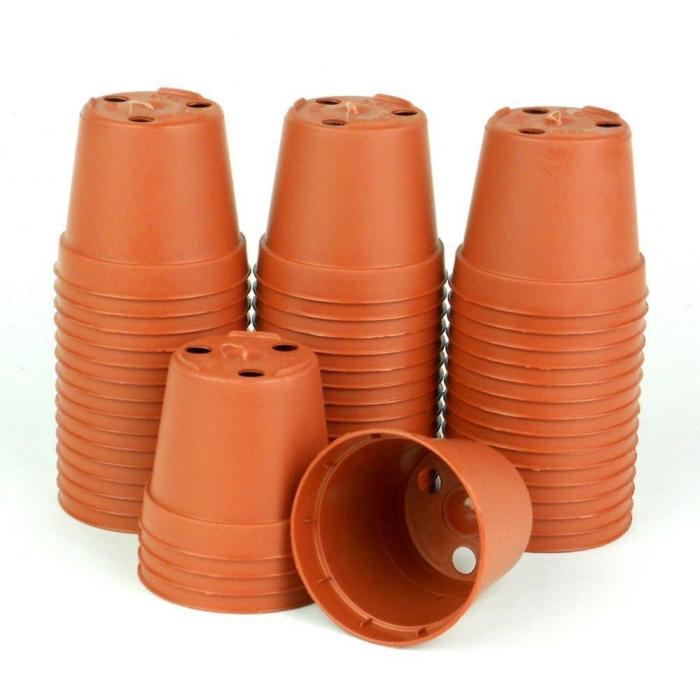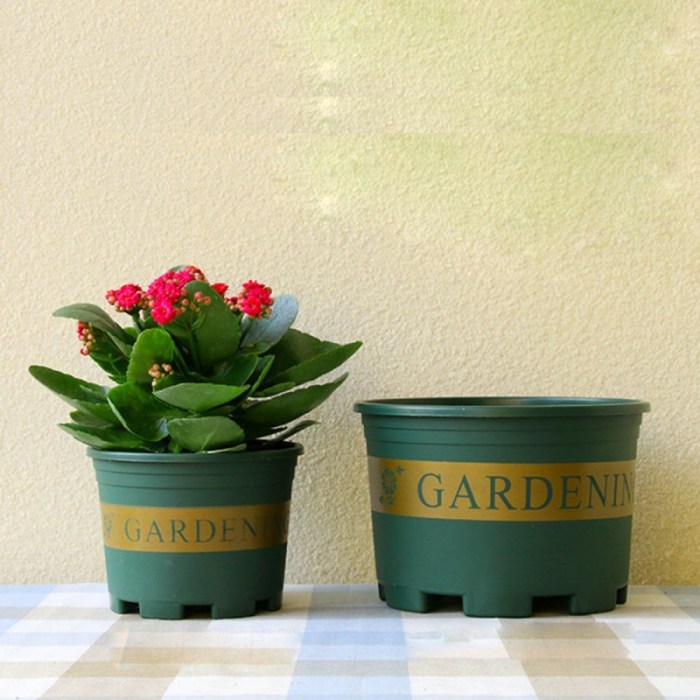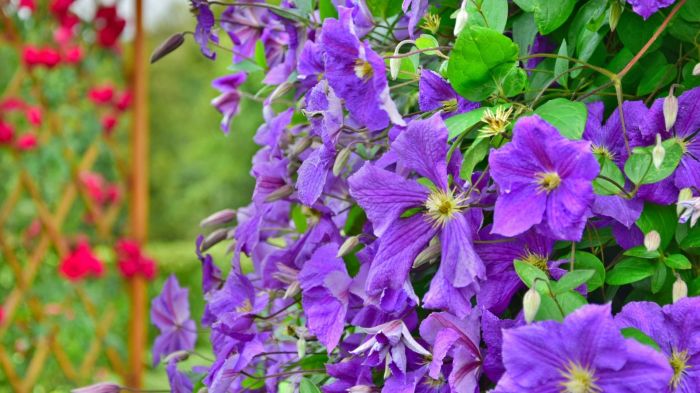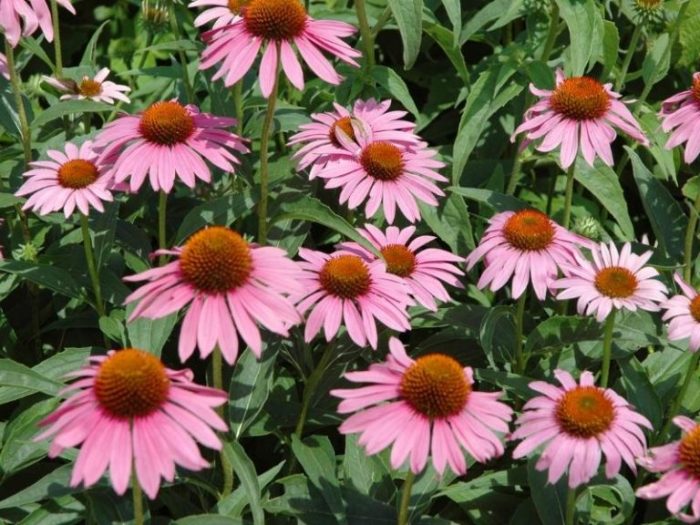Types of 2-Gallon Plant Pots

2 gallon plant pots – Choosing the right pot for your plants is crucial for their healthy growth. A 2-gallon pot offers a good balance between size and portability, making it suitable for a range of plants, from seedlings to established specimens. The material and shape of the pot, however, can significantly impact your plant’s well-being and your gardening experience.
Pot Material Comparison, 2 gallon plant pots
The material of a 2-gallon pot directly affects its durability, water retention, and overall cost. Three common materials dominate the market: plastic, terracotta, and ceramic. Each offers a unique set of advantages and disadvantages.Plastic pots are lightweight, inexpensive, and readily available. Their durability is generally good, resisting cracking and chipping, though they can degrade over time with prolonged sun exposure.
Water retention varies depending on the type of plastic; some are more porous than others. Terracotta pots, on the other hand, are porous, allowing for excellent air circulation and drainage. This breathability helps prevent root rot, but also means they dry out more quickly, requiring more frequent watering. They are relatively durable but are prone to cracking, especially in freezing temperatures.
Finally, ceramic pots offer a balance between the two. They are more durable than terracotta, less prone to cracking, and retain moisture better than plastic, but they are also generally more expensive.
Pot Shape and Style
-gallon pots come in a variety of shapes and styles, each suited to different planting needs and aesthetic preferences. Round pots are the most common, offering a classic look and are easy to handle and arrange. Square and rectangular pots, while less common in this size, can be space-saving, especially when planting in tight areas. Specialized shapes, like those designed to mimic natural environments or to showcase specific plant types, are also available, though less prevalent in the 2-gallon size.
| Shape | Typical Uses | Advantages | Disadvantages |
|---|---|---|---|
| Round | General-purpose planting, herbs, small shrubs, flowers | Versatile, easy to handle, aesthetically pleasing | Can be less space-efficient than other shapes |
| Square | Space-saving arrangements, maximizing space in a garden bed | Maximizes space, easy to arrange in rows | Can be less aesthetically pleasing to some |
| Rectangular | Larger plants needing more root space, vertical gardens | Provides more root space than round pots | Can be bulky and difficult to move |
| Specialized (e.g., self-watering) | Plants requiring consistent moisture levels | Reduces watering frequency, ideal for busy gardeners | Often more expensive than standard pots |
Plant Selection for 2-Gallon Pots: 2 Gallon Plant Pots
Choosing the right plants for your 2-gallon pots is crucial for their success. These pots offer a limited root system space, so selecting plants with appropriate mature sizes and growth habits is key to avoiding overcrowding and ensuring healthy growth. Consider the plant’s sun exposure needs and its overall size at maturity to make the best choice for your space and aesthetic preferences.
Sun Exposure Requirements and Plant Selection
The amount of sunlight your chosen plants receive directly impacts their health and growth. Different plants thrive under various light conditions, so matching the plant to its ideal sun exposure is paramount.
- Full Sun (6+ hours of direct sunlight): For full sun locations, consider compact varieties of herbs like rosemary or thyme. These plants are known for their resilience and ability to handle intense sunlight. Another excellent choice is a dwarf variety of lavender, which will maintain a manageable size within the 2-gallon pot. These choices ensure that the plant’s mature size remains suitable for the container.
- Partial Shade (2-6 hours of direct sunlight): Impatiens are a classic choice for partial shade. Their vibrant blooms and relatively compact growth habit make them ideal for 2-gallon containers. Similarly, coleus offer a wide variety of leaf colors and patterns, adding visual interest to a partially shaded area. These plants generally maintain a manageable size, thriving in the conditions provided by the 2-gallon pot.
- Full Shade (less than 2 hours of direct sunlight): For consistently shady areas, consider hostas with smaller mature sizes. These plants offer attractive foliage and tolerate low light conditions effectively. Alternatively, ferns, particularly smaller varieties, can also thrive in full shade and remain compact within a 2-gallon pot, adding a touch of delicate greenery.
Sample Planting Scheme for 2-Gallon Pots
A visually appealing arrangement can be achieved by combining plants with contrasting textures, colors, and heights. The following is a sample scheme showcasing a combination of plants suitable for 2-gallon pots, considering their mature sizes and sun exposure needs. This arrangement assumes a location with primarily partial shade.
- Centerpiece: A coleus variety with striking variegated leaves (e.g., ‘Kong Rose’ for its large, deeply colored leaves).
- Flanking Plants (two): Two Impatiens plants with contrasting flower colors (e.g., one red and one white) positioned on either side of the coleus. These will add height and color contrast.
This arrangement provides a balanced combination of foliage and flowers, creating a visually interesting display within the limited space of the 2-gallon pots. Remember to choose plants that are compatible in terms of their water and nutrient requirements for optimal growth.
Two-gallon plant pots are ideal for many plants, offering ample room for root development before transplanting. However, to manage growth and encourage bushier plants, understanding how to properly prune is crucial; learn the techniques by checking out this excellent guide on how to top a pot plant. Proper topping, combined with the appropriate pot size, significantly impacts the overall health and aesthetic appeal of your plants grown in 2-gallon pots.
Soil and Planting Procedures

Getting your 2-gallon plants off to a thriving start hinges on the right soil and planting technique. The quality of your potting mix directly impacts drainage, aeration, and nutrient availability, all crucial for healthy root development. Proper planting ensures minimal stress on your seedlings or transplants, maximizing their chances of survival and vigorous growth.
Choosing the perfect potting mix is a bit like baking a cake – you need the right ingredients in the right proportions. A well-draining, nutrient-rich blend is key. Avoid using garden soil directly, as it’s often too dense and can retain too much water, leading to root rot. Instead, opt for a specifically formulated potting mix.
Potting Mix Composition
A good potting mix for 2-gallon pots typically consists of a blend of components that provide drainage, aeration, and nutrients. A common ratio is:
- 60% Peat Moss: This provides excellent water retention and aeration. It’s light and airy, preventing compaction around roots.
- 20% Perlite: This improves drainage and aeration. The small, white, volcanic glass particles prevent the soil from becoming waterlogged.
- 20% Compost: This adds essential nutrients and organic matter, slowly releasing them as the plant needs them. Well-rotted compost is ideal, free from weed seeds or disease.
You can also add a small amount (around 5%) of vermiculite for added water retention and aeration. Always check the quality of your components – look for a peat moss that’s dark brown and fluffy, perlite that’s light and airy, and compost that’s dark and crumbly, not soggy or smelly.
Planting Seedlings or Transplants
Planting your seedlings or transplants correctly is crucial for their success. Follow these steps for optimal results:
- Prepare the Pot: Fill the 2-gallon pot about ¾ full with the prepared potting mix. Gently firm it down, leaving about an inch of space at the top for watering.
- Create a Planting Hole: Dig a hole in the center of the pot, slightly larger than the root ball of your seedling or transplant. The depth should be such that the top of the root ball is level with the top of the pot.
- Gently Place the Plant: Carefully remove the seedling or transplant from its previous container, taking care not to damage the roots. Place it in the hole, ensuring the roots are not cramped or twisted.
- Backfill and Firm: Gently fill the hole with the remaining potting mix, ensuring there are no air pockets. Firm the soil around the base of the plant, but avoid compacting it too tightly.
- Water Thoroughly: Water the newly planted specimen thoroughly, allowing excess water to drain from the bottom of the pot. This helps settle the soil and ensures good root contact.
Watering and Fertilizing
Proper watering and fertilizing are essential for maintaining healthy growth.
Water your plants when the top inch of soil feels dry to the touch. Avoid overwatering, which can lead to root rot. Water deeply, ensuring the water reaches the bottom of the pot and drains out. The frequency of watering will depend on factors such as temperature, humidity, and the type of plant.
Fertilize your plants regularly using a balanced liquid fertilizer diluted to half strength. Follow the instructions on the fertilizer label. Over-fertilizing can damage your plants, so it’s better to under-fertilize than over-fertilize. A good rule of thumb is to fertilize every 2-4 weeks during the growing season (spring and summer).
Care and Maintenance
Keeping your plants thriving in 2-gallon pots requires consistent attention to their needs. While these containers offer a manageable size, they also present unique challenges related to water retention, nutrient availability, and overall plant health. Understanding these challenges and implementing appropriate care strategies is key to successful plant cultivation. Regular monitoring and proactive adjustments will ensure your plants flourish.
Common Problems and Solutions for Plants in 2-Gallon Pots
Maintaining healthy plants in 2-gallon pots involves addressing several potential issues. These issues, if left unaddressed, can significantly impact plant growth and overall health. The following table details common problems, their causes, solutions, and preventative measures.
| Problem | Cause | Solution | Prevention |
|---|---|---|---|
| Overwatering | Excessive watering, poor drainage, compacted soil. This leads to root rot and fungal diseases. | Allow the top inch of soil to dry out before watering again. Ensure pots have adequate drainage holes. Consider using a well-draining potting mix. If root rot is suspected, repot the plant in fresh, dry soil, removing any affected roots. | Water only when necessary, checking soil moisture before each watering. Use pots with drainage holes. Choose a well-draining potting mix. |
| Underwatering | Infrequent watering, insufficient water supply, high temperatures, and low humidity. This leads to wilting, leaf browning, and stunted growth. | Water thoroughly until water drains from the drainage holes. Increase watering frequency during hot, dry periods. Consider grouping plants together to increase humidity. | Monitor soil moisture regularly. Water deeply and less frequently. Adjust watering schedule based on environmental conditions. |
| Nutrient Deficiencies | Depleted soil nutrients, lack of fertilization, or improper fertilization techniques. This manifests as yellowing leaves, stunted growth, and poor flowering. Specific deficiencies show up in different ways; for example, nitrogen deficiency shows up as yellowing of older leaves. | Use a balanced liquid fertilizer diluted to half strength every two weeks during the growing season. Conduct a soil test to identify specific nutrient deficiencies and amend accordingly. Consider using slow-release fertilizers for consistent nutrient supply. | Use a high-quality potting mix. Fertilize regularly using a balanced fertilizer. Follow fertilizer instructions carefully. Rotate crops to prevent nutrient depletion. |
| Pest Infestations | Introduction of pests through contaminated soil, other plants, or the environment. Common pests include aphids, spider mites, and whiteflies. | Inspect plants regularly for signs of pests. Treat infestations with insecticidal soap or neem oil. Introduce beneficial insects like ladybugs to control pest populations. | Inspect new plants before introducing them to your collection. Maintain good hygiene around plants. Monitor plants regularly for early detection of infestations. |
| Root Boundness | Roots circling the inside of the pot, restricting growth. This is common in small containers like 2-gallon pots. | Repot the plant into a larger container with fresh potting mix. Gently loosen any circling roots before repotting. | Repot plants every 1-2 years or as needed, based on root growth. Choose appropriately sized pots for the plant’s mature size. |
Visual Representation of 2-Gallon Pots in Use
The visual impact of a 2-gallon pot filled with a thriving plant is surprisingly significant, transforming a simple container into a vibrant focal point. The size allows for a manageable yet impactful display, perfect for adding pops of color and texture to various spaces. The right plant selection, combined with proper care, elevates the aesthetic appeal considerably.A well-placed 2-gallon pot can significantly enhance the visual appeal of a space.
Imagine the deep crimson blooms of a geranium spilling over the edges of a terracotta pot, brightening a sunny patio. Or picture a lush, green fern, its delicate fronds unfurling gracefully in a sleek, black plastic pot, adding a touch of sophistication to a minimalist balcony. On a windowsill, a brightly colored fuchsia in a cheerful yellow pot could become a miniature burst of life, injecting vibrancy into an otherwise mundane area.
The versatility of the 2-gallon pot allows for creative placement and visual customization to suit any environment.
Plant Health and Visual Appearance
The difference between a healthy and unhealthy plant in a 2-gallon pot is striking. A healthy plant will exhibit vibrant, richly colored leaves, free from blemishes or yellowing. The stems will be strong and upright, supporting the plant’s structure without wilting or drooping. The overall plant will appear full and lush, with even growth and a balanced shape. In contrast, an unhealthy plant will show signs of distress.
Leaves might be pale, yellowing, or even browning. The stems might be weak and spindly, struggling to support the plant’s weight. The overall structure may be uneven or stunted, indicating a lack of nutrients or proper care. For example, a tomato plant showing signs of blossom-end rot (a common issue due to inconsistent watering) will display dark, sunken lesions at the base of its fruit, a clear indicator of poor health, unlike a healthy plant with plump, vibrant red tomatoes.
Similarly, a spider plant with yellowing leaves and thin, weak stems shows a clear contrast to a healthy one displaying bright green, full leaves and strong stems. These visual cues serve as immediate indicators of the plant’s well-being.
Expert Answers
How often should I water 2-gallon potted plants?
Watering frequency depends on the plant, pot material, and weather. Check soil moisture regularly; water when the top inch feels dry.
What are the signs of overwatering in 2-gallon pots?
Yellowing leaves, wilting despite moist soil, and root rot (mushy roots) indicate overwatering.
Can I reuse 2-gallon plant pots?
Yes, but thoroughly clean and disinfect them to prevent disease transmission to new plants.
What size plants are best for 2-gallon pots?
Plants that remain relatively small or are young seedlings are ideal. Avoid plants with extensive root systems that will quickly outgrow the pot.



